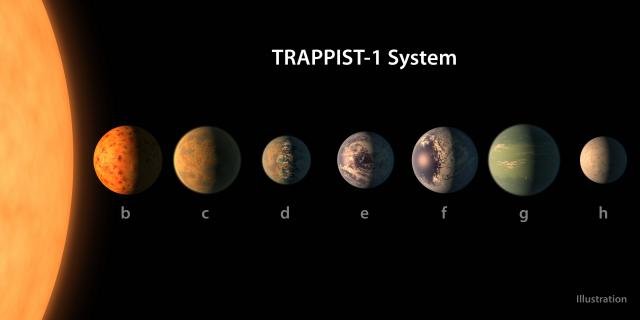
The planets that orbit the Trappist-1 star, 40 light-years "only" from our Earth, are very interesting: rocky and probably rich in water, they could prove to be cousins of our planet blue. In Chile, a new powerful and ultra-precise tool, Espresso, which will take office in October, should refine the search for heavenly bodies that are conducive to life.
Seven of a sudden! The seven recently discovered planets in orbit around the small star Trappist-1, located in our galaxy 40 light-years from Earth are rocky, contain water and could therefore host life.
"All the signals currently being studied are green," said Amaury Triaud, an astronomer at the University of Birmingham, co-author of a study published on Monday. "For the moment, no data allows us to say that they are not habitable" .
In February 2017, an international team caused a sensation by announcing that it had discovered a fascinating system of seven exoplanets of a size close to that of the Earth around the dwarf star, which is not very luminous and ultra-cold. They added that three of these exoplanets (Trappist-1 e, f and g) were in the "habitable" zone of the system, that is to say likely to harbor liquid water on the surface.
Up to 5% of their water mass
Since the astronomers have more information about the star, its planets and their atmospheres.
In particular, they were able to refine their measurements of the size and mass of the planets, determining that the seven planets were mainly rocky and that some could have up to 5% of their mass composed of water. By comparison, water is only 0.1% of the Earth's mass.
Regarding the planets' chances of harboring life, "we can not say anything at this point because they are very different from the only planet that houses life (Earth)," said Amaury Triaud.
"But they have appropriate characteristics and represent to this day the best place beyond our system to look for signs of livability and signs of life," he added.
"In terms of size, density and amount of radiation received from its star, the fourth planet is the most similar to the Earth. It seems that it is the most rocky planet of all even if the presence of water is not excluded " , specifies a statement of the CNRS which participated in the studies.
These works are published in the journals Nature Astronomy and Astronomy and Astrophysics.

A new tool to search for cousins of the Earth
Installed in northern Chile, the Espresso spectrometer, a precision never seen before, will become next October the best ally of astronomers in search of extraterrestrial life.
Unsurprisingly, it is in the Atacama desert, 1,200 kilometers north of Santiago de Chile, that Espresso will carry out its mission: a region whose sky, totally clear most of the year, has made it the ideal territory to house the most important telescopes in the world.
Within the Paranal Observatory, founded in 1998, this measurement tool will serve the four huge telescopes (VLTs) of the European Southern Observatory (ESO).
"Espresso will be available in all four telescopes at a time, which has never happened before, and therefore it increases the likelihood of finding Earth-like planets in terms of weight and size or their conditions for life" , explains Italian Gaspare Lo Curto, ESO astronomer and one of the project leaders.
The device, a simple black box in appearance, will have the immense task of gathering all the light collected from a star observed by a telescope.
By analyzing the speed of the star, it will be able to determine if a planet is spinning in orbit around it and then analyze the planet in question: its atmosphere, the presence or absence of oxygen, nitrogen, carbon dioxide or water, essential elements for life.
I like this kinds of article
Hi, I found some acronyms/abbreviations in this post. This is how they expand: